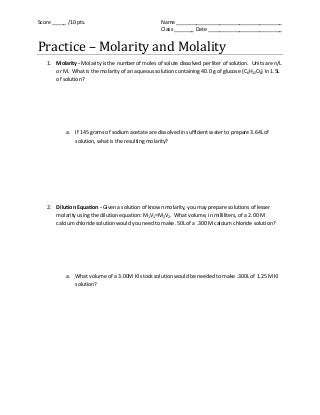
Practice molarity and molality
- 1. Score _____ /10 pts. Name _____________________________________ Class _______ Date __________________________ Practice – Molarity and Molality 1. Molarity - Molarity is the number of moles of solute dissolved per liter of solution. Units are n/L or M. What is the molarity of an aqueous solution containing 40.0 g of glucose (C6H12O6) in 1.5L of solution? a. If 145 grams of sodium acetate are dissolved in sufficient water to prepare 3.64L of solution, what is the resulting molarity? 2. Dilution Equation - Given a solution of known molarity, you may prepare solutions of lesser molarity using the dilution equation: M1V1=M2V2. What volume, in milliliters, of a 2.00 M calcium chloride solution would you need to make .50L of a .300 M calcium chloride solution? a. What volume of a 3.00M KI stock solution would be needed to make .300L of 1.25 M KI solution?
- 2. 3. Molality – Molality is the ratio of the number of moles of solute dissolved in 1 kg of solvent. It has units of n/kg or m. What is the molality of a solution containing 10.0 g of sodium sulfate dissolved in 1000.0 g of water? a. In order to prepare a 0.87 m solution of potassium sulfate, how many grams of potassium sulfate must be added to 2.00 kg of water? b. How many grams of ammonia should be added to prepare 1.25 L of water to produce a .85 m solution of ammonia? 4. Mole Fraction – Mole fraction is the ratio of the number of moles of solute or moles of solvent to the total number of moles of solute and solvent. It has no units because mole units cancel. What is the mole fraction of NaOH in an aqueous solution that contains 22.8% NaOH by mass? a. A gas mixture contains the following gases with the mole fractions indicated: bromine (.09), neon (.21), and hydrogen (.57). The mixture also contains fluorine gas. What is the mole fraction of fluorine gas?
- 3. Lab – Making and Measuring Solutions Purpose: Determine the concentration (molarity) of properly made Kool-Aid. Practice making solutions of known concentration using the dilution equation. Method: Make three solutions of Kool-Aid with different concentrations, taste them and decide which the correct concentration is. You will prepare a sample solution of each of the following molarities: 0.05 M, 0.40 M, and 1.0 M. Materials: Kool-Aid Powder – Mostly glucose Straws (to stir solutions) (C6H12O6) Scale Water A clean and dry 10mL graduated Cups, upper line = 170 mL cylinder Procedure (Part 1): Making molar solutions using a powder. 1. Calculate the mass of Kool-Aid powder needed (in grams) to make 170 mL of each solution. (Hint: Kool-Aid is mostly sugar (C6H12O6), so you can assume that the “molar mass” of Kool-Aid is the same as the molar mass of sugar.) Show all your calculations. a. Mass of Kool-Aid needed for 0.05 M solution. b. c. 2. 3. 4. Mass of Kool-Aid needed for 0.40 M solution. Mass of Kool-Aid needed for 1.0 M solution. Mass the correct amount of Kool-Aid powder needed for each solution directly into each cup. Add water to the cup until you have 170 mL of solution (fill up to the upper line.) Stir with a straw. Use the straw to taste the solutions. Record how each solution looked smelled, and tasted. Write your observations in the data table. Data Table: 0.05 M solution Mass of Kool-Aid powder (g) Observations (How it looked, smelled, and tasted) 0.40 M solution 1.0 M solution
- 4. Procedure (Part 2): Making molar solutions using a stock solution. You will not drink any of the solutions made in this part of the lab. Lab equipment is required. 1. 2. Make 170mL of a 1.0M solution of Kool-Aid using the procedure from part 1. Use the 1.0M solution as the stock solution to make 0.1L of a 0.40M solution of Kool-Aid. (Hint: Use the dilution equation M1V1=M2V2) Record measurements and observations in the data table. 3. Use the 0.4M solution just made to make 170 mL of a 0.05M solution of Kool-Aid. Record measurements and observations in the data table. Data Table (Part 2) 0.4M solution 0.05 M solution Volume of stock solution needed General observations (how it looked, smells, etc.) Questions and Conclusions 1. Which concentration tested tasted the best? What was wrong with each of the other solutions made? 2. The actual directions from Kool-Aid suggest the consumer uses 1.5 tablespoons of powder to make 1 cup of the drink. If Kool-Aid is mostly sugar (C6H12O6) what is the recommended molarity of Kool-Aid? (Hint: 1 tablespoon = 11.4 grams and 1 cup = 237 mL) 3. Describe similarities or differences between the 0.4M solution made from the powder, and the 0.4M solution made from the stock solution. 4. As you made your Kool-Aid solution, what are some things you did, or could have done, to speed up the solvation process?
- 5. 5. In order to maintain a sodium chloride concentration similar to ocean water, and aquarium must contain 3.6 g NaCl for every 100.0 grams of water. How would you express this concentration using molality (m)? 6. How would you express this concentration using a mole fraction? Do you have enough information to express this concentration in molarity (M)? If so, calculate the molarity. If not, what necessary information is missing? A 100.5mL intravenous (IV) solution contains 5.10 grams of glucose (C6H12O6). What is the molarity of this solution? 7. Do you have enough information to express the concentration in molality? If so, calculate the molality. If not, what information are you missing? Explain the similarities and differences between a 1M (molarity) solution of NaOH and a 1 m (molality) solution of NaOH. How much ammonium chloride (NH4Cl), in grams, is needed to produce 2.5 L of a 0.5 M aqueous solution? (hint: Molarity is measured by moles solute per liter solution so 0.5 M = 0.5 n/L)
